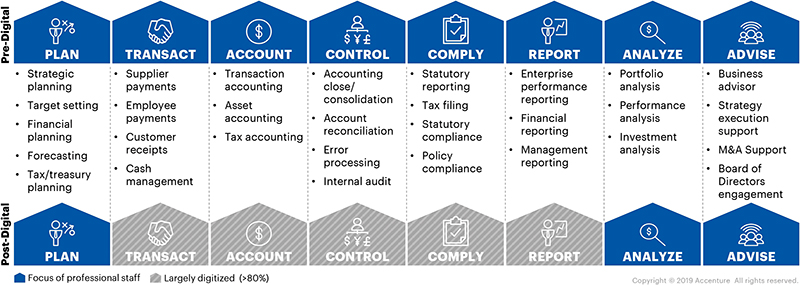Becoming a Corporate Finance Futurist
Companies demanding deeper insights and better business strategies are focusing
their finance teams on the future.
By KRISTINE BLENKHORN RODRIGUEZ | Summer 2019

“No amount of sophistication is going to allay the fact
that all of your knowledge is about the past and all your
decisions are about the future.” The words of GE’s
former strategic planner and founder of its “future
studies” group, Ian Wilson, still hold true. But finance
professionals today have more tools at their disposal
than ever to help them think like futurists and plot their
companies’ futures as well as their own.
The question remains, are artificial intelligence (AI),
robotic process automation (RPA), machine learning,
predictive analytics, and other digital technologies the
crystal balls and magic bullets so many have wished for?
Bots & Bytes
Finance roles and responsibilities are expected to be among the
most impacted by digital technologies like AI and RPA. For now,
though, many finance departments are planning for the 21st century
while working with methods still belonging to the prior.
The average corporate finance team spends roughly 80 percent
of its time on non-value-added manual processes like gathering,
verifying, consolidating, and formatting data, leaving just 20 percent
of their time for higher-level financial planning and analysis,
according to findings in Adaptive Insights’ CFO Indicator Report. So
much for being futurists.
The risk is that many of today’s finance professionals are focusing
most of their time on tasks that could soon be automated, leaving
them vulnerable as more sophisticated forms of AI and RPA creep
into daily finance functions and organizations increasingly ask for
deeper business insight and strategy from the finance team. “Very
quickly we’re going to be in a world where, if you don’t have skills
in robotics and the related technologies, you will be obsolete as a
finance person,” KPMG CFO David Turner recently told CFO.com.
At the beginning of 2019, Turner, an RPA bull, said the firm was
about 55 percent of the way toward achieving an initial goal of
creating 200,000 hours of workforce capacity savings.
Bots can process transactions, monitor compliance, and audit
processes automatically. And many of the bots being developed
today learn as they go. Through machine learning, bots improve all
on their own, based on new data and new experiences, which cuts
down on the manual work finance professionals have previously
done and, arguably, has held them back from largely becoming
more strategic business advisors.
Accenture’s David Axson, global lead of CFO strategies, says some
executives are surprised when they see just how much of corporate
finance’s day-to-day can be done by technology: “Many are
dismayed because they’ve traditionally seen their job as the preparer
of financial reports and now technology is usurping that role. What
they don’t realize is that in today’s digital era, finance’s job begins
when they deliver the report or analysis. Their role is now primarily
an advisor on major business decisions, not a report compiler.”
The scenario is increasingly playing out. In “Bots, Algorithms, and
the Future of the Finance Function,” McKinsey & Company
highlights how AI can outdo veteran talent: “At a heavy-equipment
producer, managers had long used spreadsheets to forecast
monthly sales and production. Frustrated with the time consumed
and the imprecision of manual forecasts, they tasked a team of four
data scientists with developing an algorithm that would automate
the entire process. Their initial algorithm used all the original sales
and operations data, as well as additional external information
(about weather and commodities, for example). In this case, within
six months the company eliminated most of the manual work
required for planning and forecasting — with the added benefit that
the algorithm was better at predicting market changes and
business-cycle shifts.”
Another case in point: Willis Towers Watson’s use of RPA. “Intelligent
automation boosts both day-to-day finance functions and the
quality of finance’s strategic insight,” says Willis Towers Watson CFO
Michael Burwell in an interview with CFO.com. “We use robotics to
retrieve invoices in response to various queries by state and local
tax authorities. It’s an important step, because both the number of
reviews per day and the amount of data requested is growing
exponentially. My tax team can assign the robot a task and time to
retrieve invoices in advance of a tax examination. A key advantage
of using robots is their ability to work off-peak hours when staffers
are home. When they arrive in the morning, they have invoices and
a status report to review.”
More CFOs seem to be catching on to what the future can hold for
their finance teams. According to Grant Thornton LLP’s 2019 CFO
Survey, 38 percent of senior financial executives currently
implement advanced analytics, while 30 percent have adopted
machine learning. And over the next two years, an increasing
number of CFOs will invest in AI (41 percent), RPA (41 percent),
blockchain (40 percent), and drones and robots (30 percent).
When Axson maps out the task list for corporate finance teams in the
pre-digital and post-digital worlds, it becomes clear that the traditional
role of finance must change. “Intelligent machines can sift and sort
through vast data sets — sets far too large for humans to accomplish.
And those same machines can identify patterns we humans simply
can’t because of the volume of data. Machines also do things like
this with far less error than humans do. If you want to know the impact
of changing pricing or building a new factory, AI can help faster and
in ways humans can’t,” Axson explains.

That said, Axson makes it a point to note that humans empathize,
ideate, create, and converse with each other for better solutions
far more effectively than any bot. “AI is not a cure-all. For example,
AI is not great at predicting black swan events,” he explains.
Ultimately, “CPAs need to think of themselves as more than
accountants,” Axson says. “They are moving up the value chain to
become more of a business partner and a strategic enabler —
providing solutions versus simply transactions. To do that well, it helps
if they have a strong grasp on what lies ahead for their companies.”
Becoming a Finance Futurist
Futurist, economist, and self-proclaimed human spark plug and
brain shaker, Rebecca Ryan, smiles to herself when executives think
what she does is shrouded in mystery. “’Futurist’ is a wonky term, I
know, but we’re all futurists of a sort. If you’re trying to figure out
retirement savings or the weather for your vacation, you’re doing
what I do. I just do it with a lot more training and tools,” she says.
When it comes to corporate futures, Ryan says a surprising number
of the business leaders she works with hesitate to shine a light on it.
“Most of us tend to think the future is a dark room. And we don’t want
to go in there because we don’t know what awaits us. We’re afraid
of the bogeyman.” Her job is to prove the bogeyman is a myth and
that what leaders plan for has more power to help than to hurt.
In practice, Ryan uses “The Foresight Wheel” to walk business
leaders through a futurist’s thought process, a multi-step method
of developing strategic foresight by asking “Where is the world
likely to be?” and then working backward from there.
Step 1: Frame the domain. Here, specificity is required. What do
you want to explore or accomplish and by when? Think of the future
of your company by 2025 or 2030.
Step 2: Scan for forces and trends. This is where a good futurist
helps. Ryan says she looks for forces and trends that move leaders
beyond their own biases, like the common availability bias, where
we over-rely on sources we remember instead of what’s true. In
this step, Ryan takes executives through what she calls the STEEP
areas: society, technology, economics, environment, and politics.
First, look at society. Are your customers changing? Are their
attitudes different as a new generation comes to the fore? Second,
technology. What’s on the horizon — AI? Robotics? Third, economics.
How is the gig economy or unemployment impacting your
workforce? Are your customers or clients being hit by tax regulation
or trade conflicts? Fourth, environment. With climate change, are
carbon taxes and environmental credits going to become a business
concern? Fifth and finally, politics. How will changing leadership
impact your regulatory and business environment?
Step 3a: Forecast scenarios. Many businesses plan on their best-case
scenario or what Ryan calls “rainbows and fairy dust.” It’s
aspirational, but no professional futurist will let you get away with
that scenario alone. She usually walks people through a “watch-and-wait”
future. What happens if we don’t do anything differently? Then,
an aspirational, best-case-scenario future. What happens if we have
all the right people doing the right things with the right resources?
For the third future she asks business leaders to imagine a negative
disruption. This future is filled with black-swan events. What if a client
that accounts for 20 or 30 percent of your revenue makes a sudden
change in leadership and your firm is no longer working for them?
And the fourth future envisions a positive disruption. What if two of
your biggest clients double in size?
Imagining all these futures gets people out of their boxes — optimist,
pessimist, etc. — and considering a wide range of possibilities.
Step 3b: Identify crossover issues. This is where you look at the
four scenarios you’ve just laid out and say, “What are the things we
can control that would help us regardless of which scenario plays
out?” You can’t control the economy or who comprises a major
client’s C-suite, but you can control other things like your hiring
practices, R&D, or investigating new areas of business.
Step 4: Envision the future. What is our highest vision of the future,
and what will success look like in that future?
Step 5: Backcasting. Starting from your end domain (whether that’s
2030 or just three years out), work backward to fill in your strategic
plan. What actions and outcomes need to take place to achieve
your business’s goals?
Step 6: Implement. What are the steps to take now to set your
strategic plan in motion and get you headed toward your future state?
Sparking the Conversation
Don’t mistake strategic foresight as being reserved for the C-suite.
It’s not just about how executive groups think.
“Bring some weirdos into your planning sessions,” Ryan encourages.
“And I say ‘weirdos’ in the most positive way. You should have a
stable or ecosystem of talent to choose from.” Ryan says she has
seen chief innovation officers, entrepreneurs, and young college
teaching assistants and professors fill this role, but the options are
endless — even interns could contribute.
“Have them sign an NDA and then bring their creativity and
ingenuity to your table. They will take you out of groupthink, out of
the mode in which your ‘new’ plan is just last year’s plan with slight
updates,” Ryan stresses.
She recalls one organization she worked with that had turned to its
next-generation employees to help identify ways to better attract and
retain employees. This young talent set brought six projects to the
company’s leadership team. Leaders had to green-light, yellow-light,
or red-light the ideas, but they had to give clear reasons as to why.
“I was in the restroom during a lunch break when I heard one of the
female partners at this firm exclaim that she had no idea the firm had
such talented young employees with such innovative ideas.
Sometimes, your brilliant nonconformists are right under your nose.”
While strategic foresight is still a little “out there” for many
organizations, Ryan says it can’t stay like this much longer. In a
world that is constantly changing, strategic planning will only take
you so far. Instead, be the “human spark plug” that ignites the
impetus for overcoming organizational inertia. It certainly beats the
crystal ball approach.